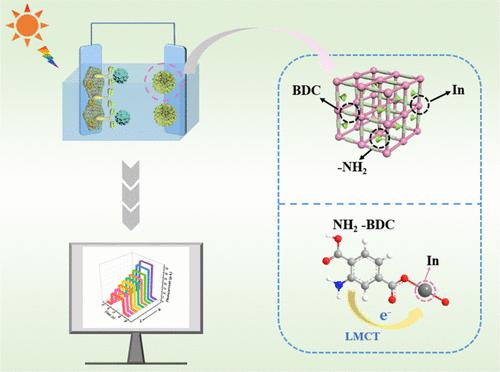当前位置:
X-MOL 学术
›
Anal. Chem.
›
论文详情
Our official English website, www.x-mol.net, welcomes your
feedback! (Note: you will need to create a separate account there.)
Design of a Double-Photoelectrode Sensing System with a Metal–Organic Framework-Based Antenna-like Strategy for Highly Sensitive Detection of PD-L1
Analytical Chemistry ( IF 6.7 ) Pub Date : 2023-05-24 , DOI: 10.1021/acs.analchem.3c01516 Yamei Li 1 , Shujun Wang 1 , Yan Zhao 2 , Yueyuan Li 1 , Ping Wang 1 , Hongqiang Xie 2 , Peiqing Zhao 2 , Yueyun Li 1 , Qing Liu 1 , Qin Wei 3
Analytical Chemistry ( IF 6.7 ) Pub Date : 2023-05-24 , DOI: 10.1021/acs.analchem.3c01516 Yamei Li 1 , Shujun Wang 1 , Yan Zhao 2 , Yueyuan Li 1 , Ping Wang 1 , Hongqiang Xie 2 , Peiqing Zhao 2 , Yueyun Li 1 , Qing Liu 1 , Qin Wei 3
Affiliation

|
Currently, the construction of heterojunctions as a method to enhance photoelectrochemical (PEC) activity has shown prospective applications in the analytical field. Restricted by carrier separation at the interface, developing a heterojunction sensing platform with high sensitivity remains challenging. Here, a double-photoelectrode PEC sensing platform was fabricated based on an antenna-like strategy by integrating MIL-68(In)–NH2, a p-type metal–organic framework (MOF) photocatalyst, as a photocathode with the type-II heterojunction of CdSe/MgIn2S4 as a photoanode synchronously. According to the ligand-to-metal charge transition (LMCT), the photo-generated carriers of MIL-68(In)–NH2 transferred from the organic ligand to the metal cluster, which provides an efficient antenna-like transfer path for the charge at the heterojunction interface. In addition, the sufficient Fermi energy difference between the double photoelectrode provides the continuous internal driving force required for rapid carrier separation at the anode detection interface, significantly improving the photoelectric conversion efficiency. Hence, compared with the traditional heterojunction single electrode, the photocurrent response of the double-photoelectrode PEC sensing platform developed using the antenna-like strategy is 2.5 times stronger. Based on this strategy, we constructed a PEC biosensor for the detection of programed death-ligand 1 (PD-L1). The elaborated PD-L1 biosensor exhibited sensitive and precise detection capability with a detection range of 1 × 10–5 to 1 × 103 ng/mL and a lower detection limit of 3.26 × 10–6 ng/mL and demonstrated the feasibility of serum sample detection, providing a novel and viable approach for the unmet clinical need of PD-L1 quantification. More importantly, the charge separation mechanism at the heterojunction interface proposed in this study provides new creative inspiration for designing sensors with high-sensitivity PEC performance.
中文翻译:

基于金属有机骨架天线策略的双光电极传感系统设计,用于高灵敏度检测 PD-L1
目前,构建异质结作为增强光电化学(PEC)活性的方法已在分析领域显示出潜在的应用前景。受界面载流子分离的限制,开发高灵敏度异质结传感平台仍然具有挑战性。在这里,通过集成 MIL-68(In)–NH 2(一种 p 型金属有机骨架(MOF)光催化剂)作为光阴极,基于类似天线的策略制造了双光电极 PEC 传感平台CdSe/MgIn 2 S 4 II异质结同步作为光阳极。根据配体到金属的电荷跃迁(LMCT),MIL-68(In)–NH 2的光生载流子从有机配体转移到金属团簇,这为MIL-68(In)–NH 2 的光生载流子提供了有效的类似天线的转移路径。异质结界面上的电荷。此外,双光电极之间足够的费米能差提供了阳极检测界面快速载流子分离所需的连续内驱动力,显着提高了光电转换效率。因此,与传统异质结单电极相比,采用类天线策略开发的双光电极PEC传感平台的光电流响应强2.5倍。基于该策略,我们构建了用于检测程序性死亡配体1(PD-L1)的PEC生物传感器。精心设计的PD-L1生物传感器表现出灵敏、精确的检测能力,检测范围为1 × 10 –5至1 × 10 3 ng/mL,检测下限为3.26 × 10 –6 ng/mL,并证明了血清检测的可行性。样本检测,为 PD-L1 定量未满足的临床需求提供了一种新颖且可行的方法。更重要的是,本研究提出的异质结界面的电荷分离机制为设计具有高灵敏度PEC性能的传感器提供了新的创意灵感。
更新日期:2023-05-24
中文翻译:

基于金属有机骨架天线策略的双光电极传感系统设计,用于高灵敏度检测 PD-L1
目前,构建异质结作为增强光电化学(PEC)活性的方法已在分析领域显示出潜在的应用前景。受界面载流子分离的限制,开发高灵敏度异质结传感平台仍然具有挑战性。在这里,通过集成 MIL-68(In)–NH 2(一种 p 型金属有机骨架(MOF)光催化剂)作为光阴极,基于类似天线的策略制造了双光电极 PEC 传感平台CdSe/MgIn 2 S 4 II异质结同步作为光阳极。根据配体到金属的电荷跃迁(LMCT),MIL-68(In)–NH 2的光生载流子从有机配体转移到金属团簇,这为MIL-68(In)–NH 2 的光生载流子提供了有效的类似天线的转移路径。异质结界面上的电荷。此外,双光电极之间足够的费米能差提供了阳极检测界面快速载流子分离所需的连续内驱动力,显着提高了光电转换效率。因此,与传统异质结单电极相比,采用类天线策略开发的双光电极PEC传感平台的光电流响应强2.5倍。基于该策略,我们构建了用于检测程序性死亡配体1(PD-L1)的PEC生物传感器。精心设计的PD-L1生物传感器表现出灵敏、精确的检测能力,检测范围为1 × 10 –5至1 × 10 3 ng/mL,检测下限为3.26 × 10 –6 ng/mL,并证明了血清检测的可行性。样本检测,为 PD-L1 定量未满足的临床需求提供了一种新颖且可行的方法。更重要的是,本研究提出的异质结界面的电荷分离机制为设计具有高灵敏度PEC性能的传感器提供了新的创意灵感。











































 京公网安备 11010802027423号
京公网安备 11010802027423号